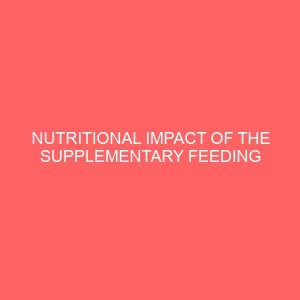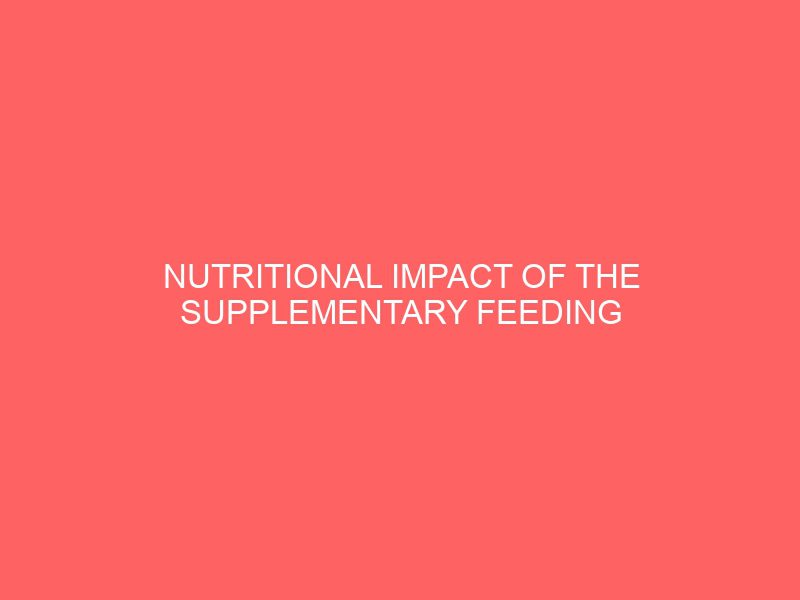Description
CHAPTER 1
INTRODUCTION
1.1 Background Information.
This research is on Nutritional impact of the supplementary feeding programme on children in rural Gboko. Under nutrition is an underlying cause of 53% of all deaths in children younger than age 5 years (WHO, 2005). The prevalence of stunting (chronic under nutrition) has dropped world wide. In developing countries, stunting dropped from 47% in 1980 to 33% in 2000 (WHO, 2000), although progress has been uneven among regions. Stunting has increased in Eastern Africa, but decreased in South-eastern Asia, South-central Asia and South America. Northern Africa and the Caribbean show modest improvement while Western Africa and Central America present very little progress (WHO, 2005).
Despite an overall decrease of stunting in developing countries, child malnutrition still remains a major public health problem in these countries. In some countries rates of stunting are rising, while in many others they remain unacceptably high (WHO, 2003).
The pattern in Africa is quite distinct. The prevalence of stunting declined from 40.5% in 1980 to 35.2% in 2000, a decrease of only 0.3 percentage points per year (WHO, 2005). The highest level of stunting is found in Eastern Africa, where, on the average, 48% of preschool children are currently affected. In this region, stunting has been increasing at 0.1 percentage points per year.
This trend, together with high rates of population increase, translates into annual increases in the numbers of stunted children in Eastern Africa. Over the period 1980–2000 the number of stunted preschool children in Africa increased from about 12.9 million to 22 million (WHO, 2005).
In Western Africa the estimated prevalence of stunting in 2004 was 35%, a proportion that has changed little in recent years. Wasting has remained around 10%, and underweight prevalence has remained roughly the same over the 1990 – 2004 periods (WHO, 2005).
The broad overall averages however tend to hide disparities between and within countries. In Nigeria, protein-energy (PEM) malnutrition is the most widespread and serious nutritional problem among children (GDHS, 2003). PEM is manifested as mild, moderate or severe stunting, wasting, and underweight. There have been slight improvements between 1998 and 2003 in rates of underweight and wasting among children under 5 years, but stunting rates deteriorated (GDHS, 2003). In 1998 stunting was 26%, wasting 10% and underweight 25 % nationally (GDHS, 1998); and in 2003, stunting was 30%, wasting 22%, and underweight, 7 % (GDHS, 2003).
Within Nigeria, there are also wide regional variations in the rates of malnutrition. Nutrition indicators for the three northern regions (the Northern, Upper East and Upper West regions) showed levels of underweight, wasting and stunting above the national average (GDHS, 2003). The Upper East has a stunting rate of 31.7%, a wasting rate of 12.9% and an underweight rate of 32.4%, while the Upper West region has a stunting rate of 34.1%, wasting rate of 11.0%, and underweight rate of 25.9%. The Northern region has the highest stunting and underweight rates of 48.8% and 35.5%, respectively, but the lowest in terms of wasting among the three regions (GDHS, 2003). Supplementary feeding programmes, operating with funds made available from local and international sources are widely used as one the strategies to reduce child malnutrition. These vary from giving supplementary foodstuffs to mothers attending maternal and child health (MCH) clinics, to community nutrition centres, nutrition rehabilitation services, food assistance such as food-for-work, and emergency feeding programmes. Almost all of these programmes focus on delivery of fortified foods and in some cases are complemented with health and nutrition education.
1.1.1 Supplementary Feeding
In Nigeria supplementary feeding programmes have been known for quite some time. The World Food Programme started operating supplementary feeding in Nigeria in 1963. Supplementary feeding programmes have been mainly targeted at preschool and school-age children as well as pregnant and lactating women in areas identified to be food insecure, poor or have persistently high rates of malnutrition. The Catholic Relief Service (CRS), The Adventist Relief Agency (ADRA) and The World Food Programme are among the main non governmental agencies that have been known to support supplementary feeding programmes in Nigeria.
The overall objective of these feeding programmes is to provide undernourished children, particularly those below the age of five years, with nutritionally balanced food to supplement their unbalanced staple diet, with the aim of ensuring normal growth and preserve health (WFP, 2005).
Most of the feeding programmes, aware of the impact of non-food factors on nutritional status, also focused on indirect strategies, including increasing MCH attendance, nutrition and health education, promotion of food production and acceptance of low-cost but nutritious foods, and other related activities.
1.1.2 World Food Programme (WFP) Assisted Supplementary Feeding Programme.
The Nigeria Health Service (GHS), in partnership with the World Food Programme (WFP) is implementing what is known as the Supplementary Feeding, Health and Nutrition Education component (SFHNE) of the food supplementation programme. This component is targeted to benefit a yearly average of 60,000 women and children in the Northern, Upper East and Upper West Regions, thus:
(i) 10,000 pregnant and lactating women and 14,000 boys and girls of 6–24 months receiving monthly takehome rations for seven months during the lean season and,
(ii) 36,000 boys and girls aged 2–5 years receiving one cooked morning meal for 260 days a year (WFP 2005).
Programme activities include providing fortified blended food, strengthening capacity and enhancing health and nutrition education at the community level. The Nigeria Health Service (GHS), in partnership with WFP carries out complementary activities aimed at significantly increasing the impact of the component in rural areas by boosting outreach services and/or community health compounds.
In targeted communities in the three northern regions, women in the second trimester of pregnancy and the first six months after delivery and children aged 6–24 months receive a micronutrient rich supplement in Community Health and Nutrition Education Centres (CHNECs).
Antenatal care for pregnant women includes a take-home ration of a fortified blended food, iodized salt and oil. In day-care/pre-school centres, children aged 2–5 receive one micronutrient-rich cooked mid-morning meal.
Community Health nurses and volunteers under the supervision of the Nigeria Health Service (GHS) sub district staff weigh pregnant women monthly and monitor the growth of the children less than 5 years.
Lactating women are counselled and supported to breastfeed their infants exclusively for six months.
1.2 Problem Statement
The nutrition of preschool children is of considerable interest not only because of concern over their immediate welfare, but also because their nutrition in this formative stage of life is widely perceived to have substantial impact on their physical and mental development and on their health status in adulthood. Their physical and mental development, in turn, shapes their lifetime options by affecting their schooling success and post-schooling productivity.
Improving the nutritional status of malnourished infants and small children may, therefore, have important payoffs over the long term.
Malnutrition can take many forms. Long-term macro or protein-energy malnutrition (PEM) usually is manifested in stunting, i.e., being short for one’s age and sex relative to standards established for healthy populations. Shorter-run PEM is often measured as wasting (low Weight-for-Height), underweight (low Weight- for-Age), and a low Body-Mass-Index (BMI).
In the northern region, 48.8 percent of children under five years are stunted and 21.8 percent severely stunted; 6.6 percent of children under five are wasted and 1 percent severely wasted. Weight-for-age results show that 36.5 percent of children under five are underweight, with 8.7 percent severely underweight (GDHS, 2003). Even though food supplementation has been operating for over a decade in the Gboko Rural areas, the rate of child malnutrition does not seem to be reducing as much as expected. In 2003 stunting in Gboko was 42.5%, underweight 41.4% and wasting 12.5% among children benefiting from the WFP food supplementation (DHMT, 2003). Sixty percent (60%) of children attending child welfare or outreach clinics in Gboko are underweight (Regional Public Health Unit, 2005).
Supplementary feeding programmes are possibly the oldest and the most common form of intervention for correcting malnutrition. A critical analysis of the Supplementary Feeding Programmes which have been undertaken around the world shows that although only a few programmes have been rigorously evaluated, it seems that in relation to their main objectives, most of them have not proved to be successful. (Rondo, 1990).
Several donor agencies as well as non-governmental agencies and churches have been carrying out supplementary feeding programmes targeting vulnerable women and children less than five years of age in the northern region. Several others are also working in various health and development areas in the Gboko metropolis and around the region. Indeed, nearly every community in Gboko is benefiting in one way or the other from the services of an NGO or a Community-Based Organization (CBO).
Key among them is the World Health Organization (WHO), the United Nation’s Children’s Fund (UNICEF), the World Food Programme (WFP), and the Catholic Relief Services (CRS). Local based organizations include Amassachina, Gubkatimali, Rural Media Network (RUMNET), Northern Regional Development Association (NORDA), Management Aid (MAID), among others.
In rural Gboko, the Word Food Programme, in collaboration with the Nigeria Health Service has been operating the supplementary feeding programme for preschool children, pregnant and lactating women in selected communities since in 1996. There are currently nine communities benefiting from the supplementary feeding programme in rural Gboko. Five others were phased out in 2006 after up to ten years on the programme. Of the nine who are still benefiting, five have been on the programme for four years and four have been on the programme for six years. Even though there have been quite a number of operational changes in the phases of the programme since its onset, the basic on-site feeding of children and take home ration for pregnant and lactating women have remained, with slight changes in the food basket. An impact study is therefore necessary to determine whether the program is succeeding in its main objective of reducing child malnutrition and whether scaling up will be beneficial.
1.3 Rationale for the study
The factors contributing to the cause of malnutrition are complex and multifaceted. They are related to morbidity patterns, care practices, mother’s level of education, environmental factors, and food and nutrition. Dietary intake is one of the main contributors to nutritional status. Mild to moderate malnutrition contributes to nearly 53% of all infant deaths in children (WHO, 2005).
Clinical assessment of nutrition disorders is not very meaningful in public health nutrition as clinical signs of malnutrition are usually late signs, thus identifying only severe cases of malnutrition. Malnutrition usually starts as mild to moderate, thus it is mainly detected in its early stages, through the use of anthropometric, biochemical or haematological methods. Growth assessment is the single measurement that best defines the health and nutritional status of children, because disturbances in health and nutrition, regardless of their aetiology, invariably affect child growth. Health and nutrition problems during childhood are the result of a wide range of factors, most of which (particularly in underprivileged populations) relate to unsatisfactory food intake or severe and repeated infections, or a combination of the two. These conditions, in turn, are closely linked to the general standard of living and whether a population is able to meet its basic needs such as food, housing, and health care. Growth assessment thus serves as a means for evaluating the health and nutritional status of children, just as it also provides an indirect measurement of the quality of life of an entire population.
Of the various anthropometric indices that can be used to assess child growth status, the following provide a comprehensive description: height-for-age portrays performance in terms of linear growth, and essentially measures long-term growth faltering; weight-for-height reflects body proportion, or the harmony of growth, and is particularly sensitive to acute growth disturbances; and weight-for-age represents a convenient synthesis of both linear growth and body proportion (WHO, 1993).
Current available data on nutritional data in the Gboko Metropolis is the GDHS, which provides data only at the regional level. The GDHS uses nationally allocated enumeration areas and the numbers that might be captured for the measurement of the nutritional indicators may not be representative of the district as well.
Baseline data prior to the start of the supplementary feeding programme in the various communities were collected but these concentrated mainly on the nutritional indicators of weight for age, weight for height and height for age. There have not been any follow up studies to the baseline in the Gboko area. Attempts by WFP to come out with a comprehensive baseline in 2005 did not include the Gboko area. Sampling of communities for that study was done from all benefiting communities in the three northern regions. It can therefore not stand as representative of any single region or district as some districts like Gboko were completely not represented.
This study determined the current nutritional status of children in beneficiary communities before the start of the programme (baseline), and the current situation in the same communities; and by this, establishes the contribution of the supplementary feeding to the nutritional status of the beneficiary children. The study also looked at some other possible contributory factors (confounders) to the nutritional status of the children.
The study in the end provided some information that will guide policy direction on nutrition interventions. Furthermore, as WFP is planning a systematic withdrawal of food support, the information provided will help the district authorities to decide whether it is worthwhile sustaining supplementary feeding when WFP finally withdraws.
1.4Conceptual Framework of the causes of malnutrition.
Malnutrition refers to a wide range of conditions, each with a specific cause related to one or more nutrients (for example proteins, iodine, calcium, or energy) and each is characterized by cellular imbalance between the supply of energy and nutrients on the one hand, and the body’s demand for them to ensure growth, maintenance and specific functions on the other (WHO, 1996).
The aetiology of early childhood malnutrition is complex, multifactoral and contextual. The major immediate cause of childhood malnutrition is deficiencies in protein and energy. However, behind these deficiencies lie a myriad of factors, acting individually or interacting with one another to influence infant feeding practices and thus their nutritional status and health.
Malnutrition ultimately results from inadequate intake of nutrients, and, or from diseases that compromise the body’s ability to digest, absorb, transport, and utilization nutrients. There are however, economic, social, cultural, political and behavioural factors causing malnutrition. These have been conceptualized into immediate, underlying and basic determinants of malnutrition (UNICEF, 2000). The immediate determinants of malnutrition are inadequate dietary intake and infections. These two also tend to interact very closely, one leading to the other; their combined or individual effect bringing about child malnutrition.
The immediate determinants are influenced by the underlying determinants, which unlike the immediate determinants manifest at the household or family level. These are food security at the household level, care for mothers and children, and healthy environment and access to health care. These exacerbate the immediate determinants to bring about malnutrition.
Food security has been defined as access for all individuals at any time to sufficient nourishing food for a healthy and active life (FAO, 1999). It therefore includes the availability of foodstuffs, the quality of the diet, the stability of supplies over time and space, and the access to food produced at home or purchased. Affecting the underlying factors from down the scale are the basic determinants. These are the potential resources (human and material) which if harnessed can have a positive effect on the underlying causes.
They consist of education and resource availability and control.
The use of supplementary feeding is therefore a strategy to address the issue of inadequate food intake as an immediate cause of malnutrition, and household food security as an underlying cause of malnutrition. Its impact on nutritional status will therefore depend on the other factors and their interactions.
1.5 Research Hypotheses
The Nutritional status (weight-for-age, height-for-age and weight-for-height) of children benefiting from the supplementary feeding programme in the rural Gboko Metropolis is better now than at the start of the supplementary feeding programme four years ago.
1.6 Research Questions.
- What is the nutritional status of children 6 months to 59 months in supplementary feeding beneficiary communities in Gboko Metropolis as compared to the start of the programme?
- Is there any significant improvement in the nutritional status of children 6 months to 59 months in Gboko since the implementation of the supplementary feeding programme?
- What other factors could influence the nutritional status of children 6 months to 59 months in Gboko Metropolis?
- What can be improved in the implementation of the supplementary feeding programme to enhance its impact on the nutritional status of children?
- Main objective of the study
The main objective of the study is to determine the nutritional impact of the World Food Programme assisted supplementary feeding programme on children 6 months to 59 months in rural Gboko.
- Specific objectives of the study
- To compare the nutritional status of children 6 to 59 months in the supplementary feeding programme communities at the start of the programme and four years later.
- To ascertain if there is a significant difference in nutritional status of children (6 to 59 months) in the supplementary feeding programme communities at the start of the programme and four years after the programme.
- To establish whether the supplementary feeding programme has had an impact on the nutritional status of children less than five years of age in the rural communities in Gboko.
- To make suggestions and recommendations to the Metropolitan Assembly, Health Directorate, and WFP.








Reviews
There are no reviews yet.